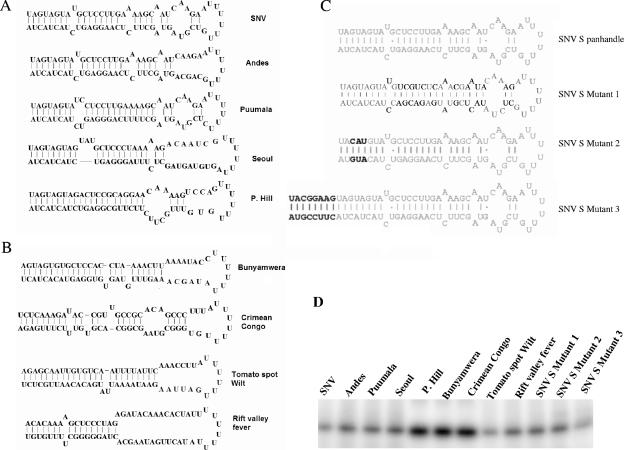FIG. 2.
S segment genomic minipanhandle RNAs. Minipanhandles corresponding to the panhandles of several bunyaviruses each contained 32 nucleotides from both the 5′ and 3′ ends of viral S segment RNA, separated by six uracil residues. RNAs were synthesized by transcription with T7 polymerase as described in Materials and Methods. (A) Probable secondary structures of S segment minipanhandle RNAs from Sin Nombre, Andes, Puumala, Seoul, and Prospect Hill viruses, belonging to the genus Hantavirus. (B) Probable secondary structures of S segment minipanhandle RNAs from Bunyamwera, Crimean Congo, tomato spot wilt, and Rift Valley fever viruses, which belong to the genera Bunyavirus, Nairovirus, Tospovirus, and Phlebovirus, respectively. (C) Probable secondary structures of the wild-type SNV S segment minipanhandle and three mutants derived from SNV. Bold letters indicate nucleotide substitutions relative to the wild-type sequence. In SNV S mutant 3, extra nucleotides have been added to both the 5′ and 3′ ends of the RNA, such that they undergo additional base pairing and extend the stem structure in the panhandle. The secondary structures of all panhandles, except that of Rift Valley fever virus, are highly probable. Some of the nucleotides in the Rift Valley fever virus panhandle might undergo alternative hydrogen bonding with the middle uracil loop. (D) Twelve-percent acrylamide-8 M urea gel of minipanhandles, from panels A, B, and C. These panhandles were synthesized by in vitro T7 transcription reaction, radiolabeled during synthesis (described in detail in Materials and Methods), run on 12% acrylamide gels containing 8 M urea, and visualized by phosphorimaging. P. Hill, Prospect Hill virus.

